Author and Editor: Monchi
1. Bitcoin Market
From July 26 to August 1, 2025, the specific trends of Bitcoin are as follows:
July 26 : Bitcoin rebounded sharply, rising gradually from $115,844. It hit $117,768 at midday before a slight pullback and continued its upward trend, reaching an intraday high of $118,257 in the evening. It then consolidated around $118,000, indicating that short-term bulls were attempting to consolidate their upward momentum.
July 27 : The market continued its upward trend from the previous trading day, briefly retracing to $117,903 after the opening, but buying support was evident below. Subsequently, bulls gradually gained momentum, pushing the price up to $118,365. Although it subsequently fell back to $117,905, the bearish momentum was limited. Bulls accelerated their advance in the evening, pushing the price up to $119,009 before the close, a new high for the period, and intensifying bullish sentiment in the market.
July 28 : Bullish momentum continued, with Bitcoin quickly breaking through its previous high at the opening bell, rallying to $119,501. Despite two minor intraday pullbacks, the bullish momentum persisted, with the intraday high reaching $119,788. The upward momentum subsequently weakened, prompting profit-taking, and Bitcoin prices began to correct, gradually falling back to $118,814. Despite attempts to stabilize at this level, the upward move failed, and Bitcoin fell again to $118,008 in the evening, signaling the end of its short-term upward trend.
July 29 : Bitcoin initially found support at $118,000. After a brief rebound at the start of the session, the price remained weak, falling further to $117,441. A quick rebound followed, pushing the price back above $118,000 and maintaining a high level of volatility. Short sellers subsequently re-appeared, sending the price plummeting to $117,490. However, bulls quickly responded, with capital entering the market and pushing the price up rapidly to $118,739. The rise continued to $119,083. Despite a pullback in the evening, the price remained above $118,976. The price ultimately closed at $117,369 for the day, demonstrating a pattern of rising and falling prices.
July 30 : Continuing the previous day's weak pattern at the end of trading, Bitcoin continued to fall after the opening bell, reaching a low of $117,187, where it found short-term support. Bulls attempted a counterattack, and after a period of volatility, the market gradually stabilized and began a fluctuating upward trend, forming a clear upward trend. The retracement lows continued to rise, reaching an intraday high of $118,467. However, pressure emerged at the upper levels, and bears quickly countered, sending the price plummeting to $117,472. A fierce battle ensued around $118,000, with bulls surging again, pushing the price back to $118,613. However, the price failed to stabilize and fell back to $117,700, indicating that the short-term trend remains range-bound, with the direction still uncertain.
July 31 : Bitcoin experienced significant intraday volatility, with a sudden, sharp pullback immediately after the opening bell. The price plummeted from $117,790 to a low of $116,000. Bulls then quickly stepped in, pushing the price back up to $117,218. The market then entered a period of volatile upward movement, gradually climbing to a peak of $118,872. However, resistance emerged at higher levels, leading to a slight pullback to $117,855 before rebounding again, reflecting a fierce battle between bulls and bears at a key position. The price ultimately closed at $118,283, essentially recovering all of the day's losses, demonstrating a V-shaped trend characterized by a sharp decline and then a high-level fluctuation.
August 1 : Bitcoin's volatility deepened, reaching a daily high of $118,764 shortly after the opening bell. However, it encountered strong resistance, quickly shifting to bearish dominance and entering a period of continuous decline. The price subsequently dipped to $117,557, $116,482, and $116,049, failing to find effective support at each level. Bearish sentiment persisted. Ultimately, Bitcoin's decline temporarily halted near $115,296, marking its largest drop of the day. As of press time, Bitcoin was trading at $115,516, representing a 2.73% drop (based on the high of $118,764). Overall, the market is entering a correction after repeated unsuccessful fluctuations at high levels. Further declines may remain in the short term, and the strength of support around $115,000 needs to be monitored.
Summarize
This week, the market showed a "high-level fluctuation + double-kill downward" structure, especially in the two deep declines on July 31 and August 1, reflecting that the market was under pressure at high levels, short-term risk sentiment quickly heated up, and the trend gradually shifted from a strong and volatile trend to an adjustment stage.
In the first half of the week (July 26-28), Bitcoin continued its rebound momentum from the previous weekend, climbing steadily from $115,844 to a high of $119,788, a new high for the period and demonstrating positive bullish sentiment. However, starting on July 28, signs of profit-taking emerged, and Bitcoin prices entered a period of repeated volatility: high-level fluctuations, pullbacks, renewed surges, and further pullbacks. From July 28 to 31, Bitcoin prices retreated to $117,441, $117,187, and $116,000, forming a series of downward trends. However, bulls managed to organize rebounds, and the price remained in a consolidation range above $118,000, fluctuating within a narrow range between $118,000 and $119,000. From July 31 to August 1, market sentiment shifted sharply, with bearish forces unleashed in a concentrated manner. Two deep declines formed a "double kill" pattern at high levels, disrupting the previous volatile balance.
In the short term, the market's divergence between bulls and bears is intensifying, with significant pressure above $118,000, while $115,000 has become a key support level. If Bitcoin fails to maintain $115,000, it may continue to search for support downward, entering a period of consolidation. Investors should closely monitor market trading volume and the gains and losses of key technical levels to determine whether a directional breakout is imminent.
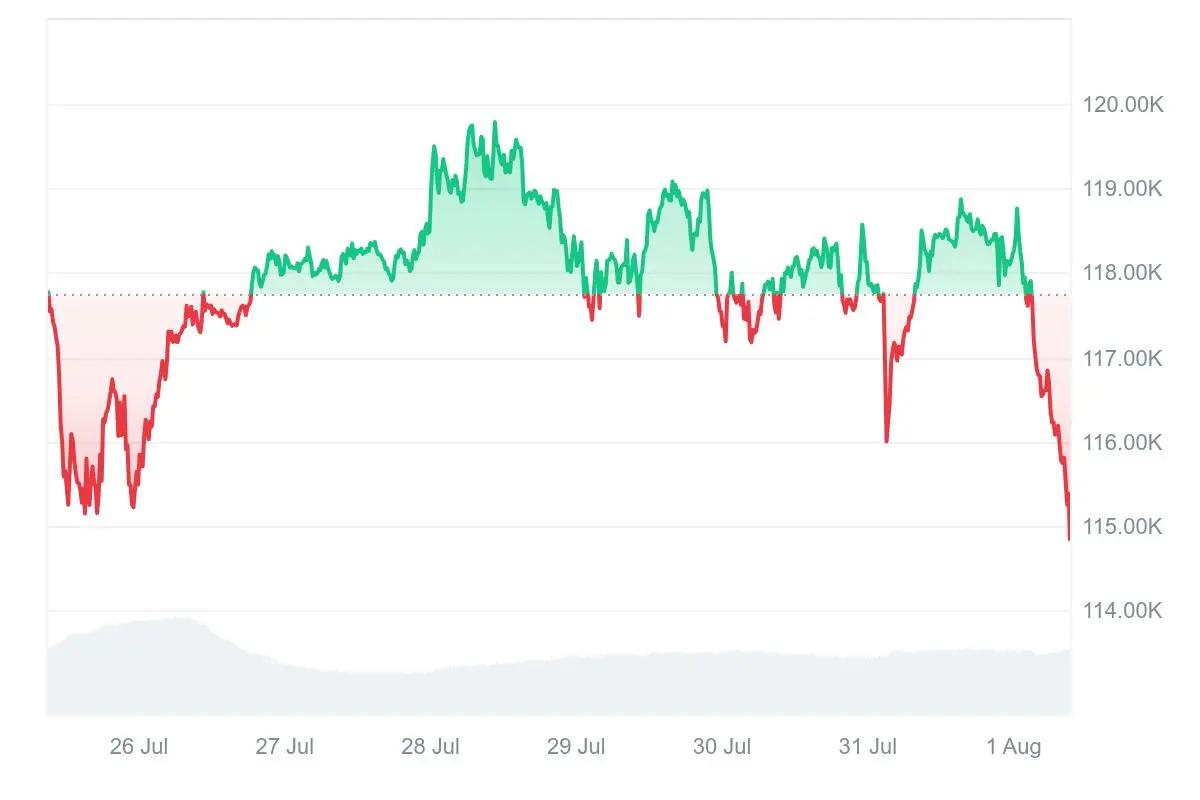
Bitcoin price trend (July 26, 2025 - August 1, 2025)
2. Market dynamics and macroeconomic background
Capital Flows
1. Large Investors' Portfolio Adjustments and Whale Behavior
According to Glassnode data, large wallets (holding more than 1,000 BTC) reduced their holdings by a total of approximately 13,800 BTC between July 26 and 29, mainly selling in batches when the Bitcoin price approached $118,000.
During the same period, inflows into exchanges exceeded outflows for the first time, suggesting that some funds may be investing in stablecoins or other assets, awaiting opportunities. Both the growth in new addresses and the number of daily active users declined, indicating a cooling of retail investor enthusiasm (active users fell below 850,000).
2. Large sell-offs were successfully absorbed, and price fluctuations were limited.
Galaxy Digital sold approximately 80,000 BTC (approximately $900 million) on behalf of early BTC holders between July 17 and 25, creating a historic transaction volume that barely impacted the market. The price briefly dipped to $116,000 before rebounding to over $119,000. This event demonstrates the significant maturity of the Bitcoin market, with the institutions and execution capabilities to support large-scale transactions without triggering significant price fluctuations.
3. The supply ratio of Bitcoin to long-term holders is declining
On July 30th, Glassnode data showed that the ratio of Bitcoin's long-term to short-term holders (LTH/STH) supply decreased by 11% over the past 30 days, indicating a continued shift of funds into the circulating market. Meanwhile, the market share of Ethereum futures open interest rose to nearly 40%, the highest level since April 2023, indicating a shift in investor attention from Bitcoin to Ethereum. This figure is in the top 5% of all time.
4. Derivatives Market: ETH and Altcoin Trading Heat Continues to Rise
Capital flows in the derivatives market are undergoing structural changes. By the end of July, the open interest share of Ethereum futures contracts rose to nearly 40%, the highest since April 2023 and in the top 5% of historical data, indicating a shift in capital and speculative interest from Bitcoin to Ethereum.
According to CryptoQuant data, ETH has recently surged 170%, placing it just 23% away from its all-time high. SharpLink announced a $1.3 billion purchase of 438,190 ETH, contributing to this surge. Meanwhile, trading in ETH and Altcoin contracts has also continued to heat up.
Data shows that as of July 31st, the total trading volume of Ethereum and Altcoin futures contracts reached $22.36 billion, a five-month high. On centralized exchanges, these contracts accounted for 83% of the total, while Bitcoin futures only accounted for 17%. The market landscape is gradually transitioning from a "Bitcoin-dominated" one to a "multi-asset dynamic."
5. ETF funds continue to flow in
This week's daily ETF inflow/outflow details:
July 28: +$157.1 million
July 29: +$80 million
July 30: +$47.1 million
July 31: -$133.4 million

ETF inflow/outflow data image
ETF products continue to attract funds, with a clear trend of institutional allocation. Although there was a small net outflow on July 31, the overall weekly net inflow pattern remained.
Furthermore, Nate Geraci, president of The ETF Store, noted that companies have raised nearly $86 billion through ETFs to purchase Bitcoin and other crypto assets so far in 2025, more than double the total amount raised through US IPOs in 2025. This data highlights Wall Street's growing attention to crypto assets, and ETFs are gradually becoming a key channel for promoting the mainstreaming of crypto assets.
Technical indicator analysis
1. Relative Strength Index (RSI 14)
According to Investing.com data, as of August 1, 2025, Bitcoin's 14-day Relative Strength Index (RSI) was 27.573, significantly below the technical threshold of 30 and entering oversold territory. The current RSI reading is nearing an extremely low level, typically indicating pessimistic market sentiment, heavy selling pressure, and a potential release of short-term downward price momentum. Historically, such a situation often precedes a short-term technical rebound or bottoming out. Although the RSI has entered the oversold zone, no clear reversal signal (such as an RSI divergence or a significant rebound) has yet to appear. If the RSI remains between 25 and 30 over the next few days, accompanied by stable or low-level price fluctuations, a bottoming divergence pattern could form, suggesting a potential bottoming or rebound opportunity. However, if the RSI falls below 25 or even lower, it would signal extreme panic and heighten market concerns about Bitcoin testing further support levels.
2. Moving Average (MA) Analysis
5-day moving average (MA5): $117,499
20-day moving average (MA20): $117,366
50-day moving average (MA20): $112,037
100-day moving average (MA100): $102,271
Current market price: $115,091
MA5, MA20, MA50, MA100 data images
Short-term perspective: The current price has fallen below both the MA5 and MA20 levels, indicating a significant weakening of the short-term trend and a bearish trend. A death cross has formed between the MA5 and MA20 levels, suggesting a potential downward trend in the short term.
From a medium- to long-term perspective: Although the current price remains above both the MA50 and MA100, the gap between the price and the MA50 is narrowing. If the price continues to decline, a medium-term death cross could form, exacerbating the depth and duration of the trend correction. The overall moving average system shows a pattern of blunting tops and gradually turning downward, reflecting a shift in market momentum after a prolonged period of high-level volatility.
Technical Conclusion: The order of the moving averages (short-term breakout, mid-term critical, long-term bullish) suggests the market is in the early stages of a correction, evolving into a mid-term correction. A subsequent break below the 50 MA (112,037) would constitute a technical breakdown and could trigger a deeper pullback, with support levels between 110,000 and 105,000 being key.
3. Moving Average Convergence Divergence (MACD) Analysis
According to Investing.com data, as of August 1st, the MACD fast line was -631, and the histogram remained negative and showed signs of widening. The MACD is currently exhibiting a clear bearish divergence pattern, with the fast line continuing to dip below the zero axis and the histogram showing increasing momentum. This indicates a strengthening bearish trend and continued strong selling pressure in the market. The ACD has not yet diverged significantly from price action, suggesting the current downtrend has yet to show signs of significant momentum exhaustion. The MACD maintains a bearish trend, signaling a medium-term "sell" signal. If the histogram shortens and forms a golden cross, this could signal a trend reversal. At this point, caution is advised against a "decline relay" pattern, which involves a short-term rebound followed by a subsequent test of the bottom.
4. Key support and resistance levels
Support Levels : Bitcoin's current key short-term support levels are $115,000, $116,000, and $117,000. The market's performance over the past seven days demonstrates the effectiveness of this support level, demonstrating relatively strong buying momentum. Around July 26th, BTC prices dipped to around $115,000 twice, only to quickly find support and rebound significantly, demonstrating significant capital inflow below this range. During the deep correction on August 1st, $115,000 again served as support, halting the decline and further consolidating its key position. On July 30th, prices retreated to around $117,000 twice, both times halting their decline and establishing short-term support. On July 31st, despite a brief, rapid decline, BTC prices briefly dipped to $116,000, but then rebounded strongly to $117,000. After a brief period of sideways consolidation in this area, the upward momentum continued, breaking through $118,000, indicating that bulls still have the initiative in this range. Overall, the $115,000-$117,000 range constitutes the current market's core support zone. Sustained movement above this range will further consolidate the short-term bullish structure; however, a break below $115,000 will require attention to the secondary support below.
Resistance : Bitcoin's current short-term resistance structure is relatively clear, with the initial resistance level located between $118,000 and $119,000, and above that lies the crucial $120,000 level. On July 28, BTC briefly broke through $119,000, but was unable to maintain its position due to insufficient momentum and selling pressure from above. Subsequently, on July 29 and 31, Bitcoin encountered resistance at $119,000 during its upward breakout attempts, encountering strong resistance, demonstrating that this level has become a key barrier to a short-term breakout. The $118,000 level has been a key technical indicator of recent market volatility, with frequent bullish and bearish battles, serving as a key indicator of market strength. As for $120,000, it represents not only a previous high but also a psychologically significant round number. Without significant positive news or strong volume support, a breakout above this level will be challenging. At present, the $118,000-$120,000 range constitutes the main pressure zone for Bitcoin in the short term. Only when it breaks through and stabilizes at $120,000 with large volume can the market usher in further upward space.
Comprehensive analysis
Overall, Bitcoin is currently experiencing a pattern of high-level volatility followed by a double-dip decline. The sharp declines on July 31st and August 1st, in particular, clearly reflect the market's fluctuating sentiment and loosening of holdings after coming under pressure at high levels. The market is gradually shifting from its previous period of volatile strength to a period of short-term correction. There is a significant divergence between bulls and bears in the current market, with significant pressure above $118,000, and $115,000 becoming a critical barrier for this period. If the price fails to hold above this support level, Bitcoin may enter a new round of consolidation or a test of a bottom. Conversely, if it can maintain steady movement above this support level, the short-term bullish structure is expected to re-establish, potentially creating another opportunity for upward momentum. Investors are advised to closely monitor the offensive and defensive dynamics in the $115,000-$120,000 range, focusing on combining volume changes with macro sentiment indicators for risk management and trading decisions.
Market sentiment analysis
1. Emotional Profile
This week, Bitcoin market sentiment exhibited a dynamic evolution, with optimism in the first half of the week followed by a shift toward caution in the second half. Prices continued to fluctuate within a high range, with volatility increasing significantly, reflecting a sensitive phase in the market's directional trajectory. Early in the week, prices rose to test a temporary high, boosting risk appetite and buoyant investor sentiment, with bullish sentiment dominating the market. However, as prices approached technical resistance levels, market expectations gradually diverged, sentiment shifted toward caution, and a wait-and-see attitude intensified. Towards the end of the week, the market experienced two rapid and deep pullbacks, resulting in significant short-term market shakeouts and significant swings in sentiment. Overall, market sentiment shifted from optimism to caution, and then to a wait-and-see stance amidst significant volatility, with significant fluctuations in investor sentiment.
Specifically, the price began a short-term rally around $115,000 on July 26, reaching a high of $119,788 on July 28, a cumulative increase of nearly 4%. This marked a significant increase in bullish sentiment in the market, with FOMO (fear of missing out) spreading and driving a resurgence in market activity. However, starting on the evening of July 28, Bitcoin entered a wide range of high-level fluctuations. From July 29 to 31, a correction began, with the retracement lows gradually shifting downwards, indicating a weakening of bullish momentum and a simultaneous decline in sentiment, leading some investors to adopt a conservative approach. On July 31 and August 1, the market experienced consecutive sharp declines, with short-term trading sentiment intensifying, reflecting an unstable and volatile market, with a significant increase in sentiment volatility and short-term uncertainty.
2. Key Sentiment Indicators (Fear and Greed Index)
As of August 1, the Fear & Greed Index was temporarily reported at 57, which is at the lower end of the "Greed" range and has fallen from its previous high. This reflects that although the current market risk appetite still exists, it has shifted from the previous excitement to a relatively cautious state. Investors have shown a stronger sense of risk control at the current high level.
Looking back at this week (July 26–31), the daily readings of the Fear & Greed Index were: 64 (Greed), 64 (Greed), 67 (Greed), 63 (Greed), 63 (Greed), and 62 (Greed). The index remained between 62 and 67 this week, with limited overall volatility, remaining in the "Greed" range. This indicates that overall investor confidence remains, but sentiment has cooled somewhat. Structurally, the index peaked on July 28, coinciding with Bitcoin's periodic high. It has subsequently gradually declined, reflecting a market retreat after a failed attempt to push higher. Some funds have begun reducing their positions to avoid risk, ushering in a period of market speculation and divergence.
Furthermore, sentiment indicators and price trends show a certain degree of divergence: although prices remain in a high range, the Fear and Greed Index has failed to reach a new high and instead continues to decline, indicating that the current market has entered a high-level game, and insufficient sentiment support may suppress prices. From the perspective of investor behavior, short- and medium-term traders have generally begun to reduce their risk exposure, preferring to wait for clearer market direction signals.
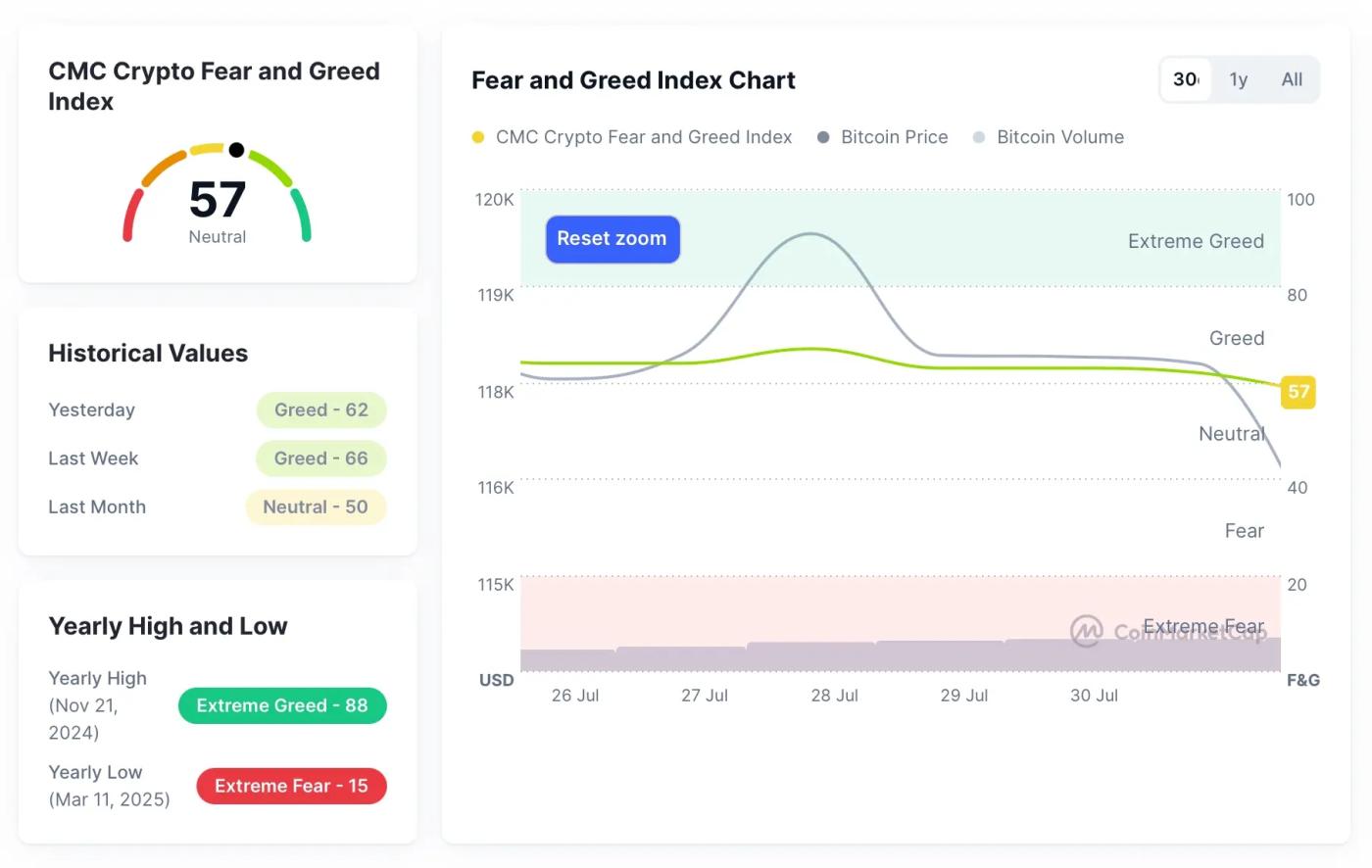
Fear and Greed Index data chart
Macroeconomic background
1. Fed and Powell dynamics
On July 30th, the FOMC decided to maintain interest rates in the 4.25%–4.50% range, but two members dissented, a first since 1993, dampening market expectations of a rate cut before September. Overall, the market anticipates the Fed will be reluctant to ease monetary policy. As a risky asset, Bitcoin has shown caution and weakened briefly. Some believe Bitcoin would benefit if the Fed sends a more dovish signal, but this meeting did not clearly signal such a move.
2. Trump, policy, and regulatory trends
The White House released a digital asset report titled "Strengthening American Leadership in Digital Financial Technology," emphasizing the promotion of the Genius Act and the Clarity Act, explicitly opposing the issuance of a central bank digital currency by the United States, and proposing a policy concept of maintaining and implementing a "strategic Bitcoin reserve" (although the report did not mention any new purchase plans).
Trump continued to put pressure on Powell, criticizing him for not being aggressive enough in cutting interest rates and even considering replacing the Fed chairman, which triggered market concerns about the independence of the central bank, raised inflation expectations, and put pressure on the US dollar.
3. Macro liquidity and ETF momentum
A Citi report indicates that Bitcoin's recent surge is primarily driven by ETF inflows and overall institutional adoption, with the impact of traditional miner costs and the stock-to-flow model waning. Last week, Bitcoin ETFs saw net inflows of approximately $72 million, marking the seventh consecutive week of net inflows and demonstrating continued strong institutional demand. Ethereum ETFs performed even better, with a single-week net inflow of $1.8 billion, suggesting a shift in funds towards Ethereum. The cumulative M2 money supply growth of 2.3% by 2025, including a 0.63% monthly increase from May to June, is a key factor supporting bullish sentiment towards Bitcoin.
4. The US dollar rebounded strongly, and global markets came under pressure
The strong rebound in the US dollar has put pressure on global markets. Contrary to previous expectations that Trump's tariffs and fiscal policies would weaken the dollar and US markets, strong economic data, an AI-driven stock market rally, and diminished concerns about the US outlook have changed these perceptions. The dollar is expected to see its first monthly gain since 2025, while Europe and emerging markets, which previously benefited from anti-dollar sentiment, are now under pressure. A stronger dollar typically dampens the appeal of non-dollar assets such as Bitcoin, potentially leading to short-term capital outflows from the crypto market and pressuring Bitcoin prices. However, in the long term, if the dollar remains volatile at high levels, investors may still seek Bitcoin as an inflation hedge.
5. Indian economy: Trump tariffs impact growth expectations
Trump announced a 25% tariff on Indian goods, projected to reduce India's economic growth by approximately 40 basis points in the 2025-26 fiscal year. Economists warn that additional tariffs could further drag down India's economy. As an emerging market economy, India's slowing growth may weaken local demand for crypto assets. However, due to the limitations of the traditional financial system, demand for cryptocurrencies for asset diversification and cross-border fund transfers remains strong.
6. Global Economic Outlook: IMF lowers growth forecast
The International Monetary Fund (IMF), in its July 2025 World Economic Outlook Update, noted that the global economy faces downside risks. It projected global growth to be 3.0% in 2025, down 0.2 percentage points from its previous forecast. The trade environment remains fragile, and tariffs could be re-increased after the "pause" period, leading to a potential 0.3% decline in global output in 2026. Slowing global economic growth and escalating trade tensions could encourage more investors to view Bitcoin as "digital gold" and seek a safe haven, driving up demand for the asset. However, economic uncertainty could also increase market volatility.
3. Hash rate changes
Between July 26 and August 1, 2025, the Bitcoin network hash rate fluctuated as follows:
On July 26, the network's hash rate fluctuated slightly, gradually declining from 1.0345 ZH/s to 951.31 EH/s. It then climbed slightly to 1.0011 ZH/s in the evening, before falling back to 961.34 EH/s by the end of the day, slightly below its intraday high. On July 27, the hash rate continued to decline, dropping from 974.62 EH/s to 885.01 EH/s and then 840.79 EH/s, before recovering slightly to 851.42 EH/s by the end of the day, indicating a weakening trend in miners' hash rate release. On July 28, the hash rate experienced significant fluctuations, rising rapidly from 847.64 EH/s to 1.0792 ZH/s, a temporary high. However, it subsequently retreated sharply, closing at 863.24 EH/s. The significant intraday fluctuations indicate increased volatility in network computing power. On July 29, the hash rate continued its downward trend, rapidly declining from its high to a low of 687.43 EH/s. Although it rebounded to 732.71 EH/s midway through the day, it subsequently fell back to 684.61 EH/s, closing at 715.03 EH/s, suggesting that some miners may be temporarily offline or migrating their computing power. On July 30th, the hash rate recovered somewhat, rebounding from its low to 878.97 EH/s. Despite a brief pullback, the overall upward trend persisted, reaching a high of 913.66 EH/s during the day before dipping slightly to 840.51 EH/s at the end of the day, indicating a slight recovery in miner activity, though still unstable. On July 31st, the hash rate continued its upward trend, gradually climbing from 835.58 EH/s to 1.0521 ZH/s, essentially returning to its early-week level. This suggests a resurgence in network computing power and increased miner activity.
From July 26 to August 1, 2025, the Bitcoin network hash rate exhibited significant overall volatility. From the 26th to the 27th, the hash rate continued to decline, reflecting temporary downtime or reductions in hash rate by some miners due to factors such as electricity prices, weather, or maintenance. From the 28th to the 29th, the hash rate experienced significant fluctuations, experiencing rapid increases and deep drawdowns, fluctuating by nearly 400 exahashes per second (EH/s), significantly impacting network stability. From the 30th to August 1st, the hash rate entered a phased recovery phase, gradually recovering to around 1 ZH/s, indicating that some miners had returned online and network activity was rebounding.
Overall, the significant fluctuations in hash rate during this period reflect the continued uncertainty in the distribution of network computing power, potentially influenced by external factors such as weather conditions, electricity costs, and equipment maintenance status. Despite some recovery towards the end of the week, the network has yet to demonstrate a stable upward trend, necessitating continued monitoring of the potential impact of hash rate fluctuations on subsequent block intervals, block confirmation times, and mining difficulty adjustments.
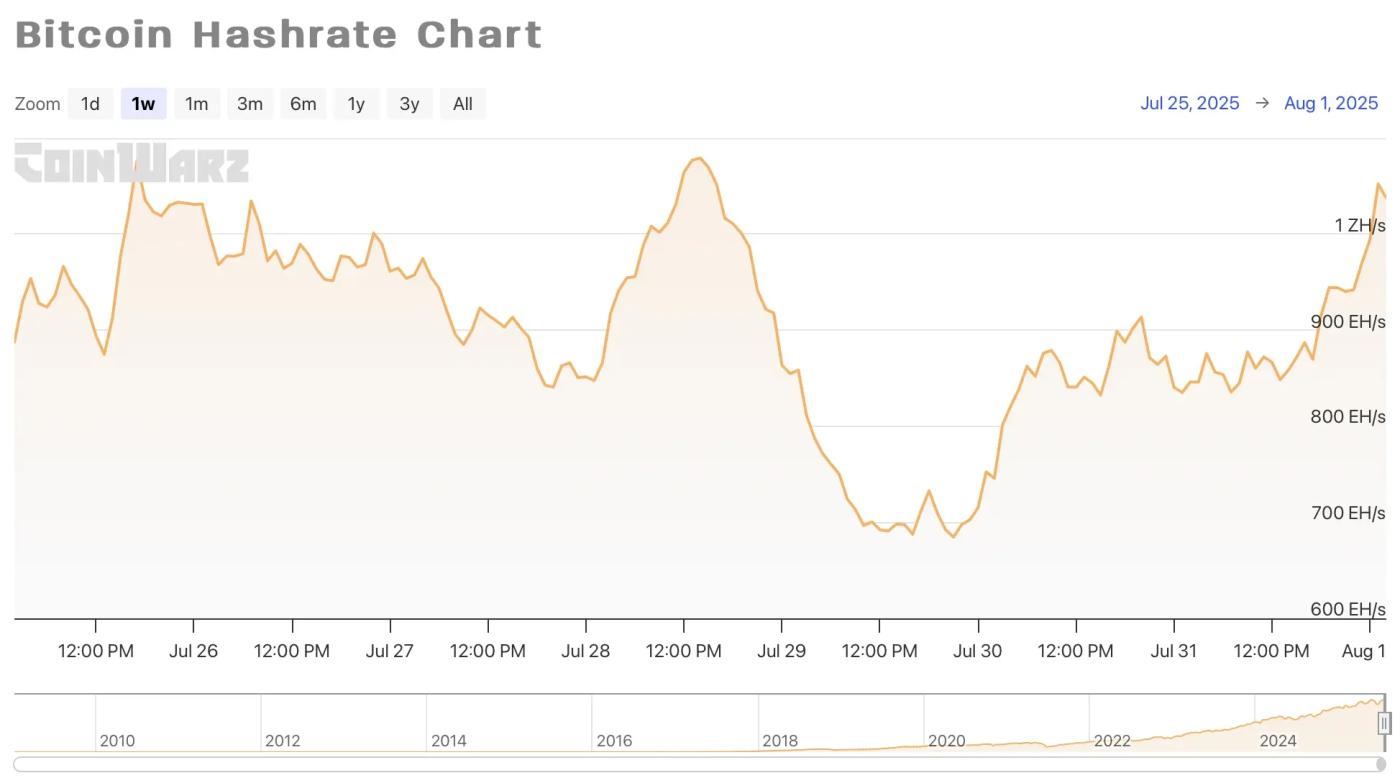
Weekly Bitcoin network hash rate data
Data from the past six months shows that the Bitcoin network hash rate has shown a steady upward trend. Despite occasional sharp fluctuations in the short term, the overall trend reflects miners' optimism about the long-term prospects of the Bitcoin network and the continued deployment of efficient mining equipment, providing hash rate support. Since the beginning of 2025, the hash rate has steadily increased from the 700–800 EH/s range to a current level of 800–1000 EH/s, even periodically exceeding 1 ZH/s, signaling the formation of a new cycle of hash rate expansion.
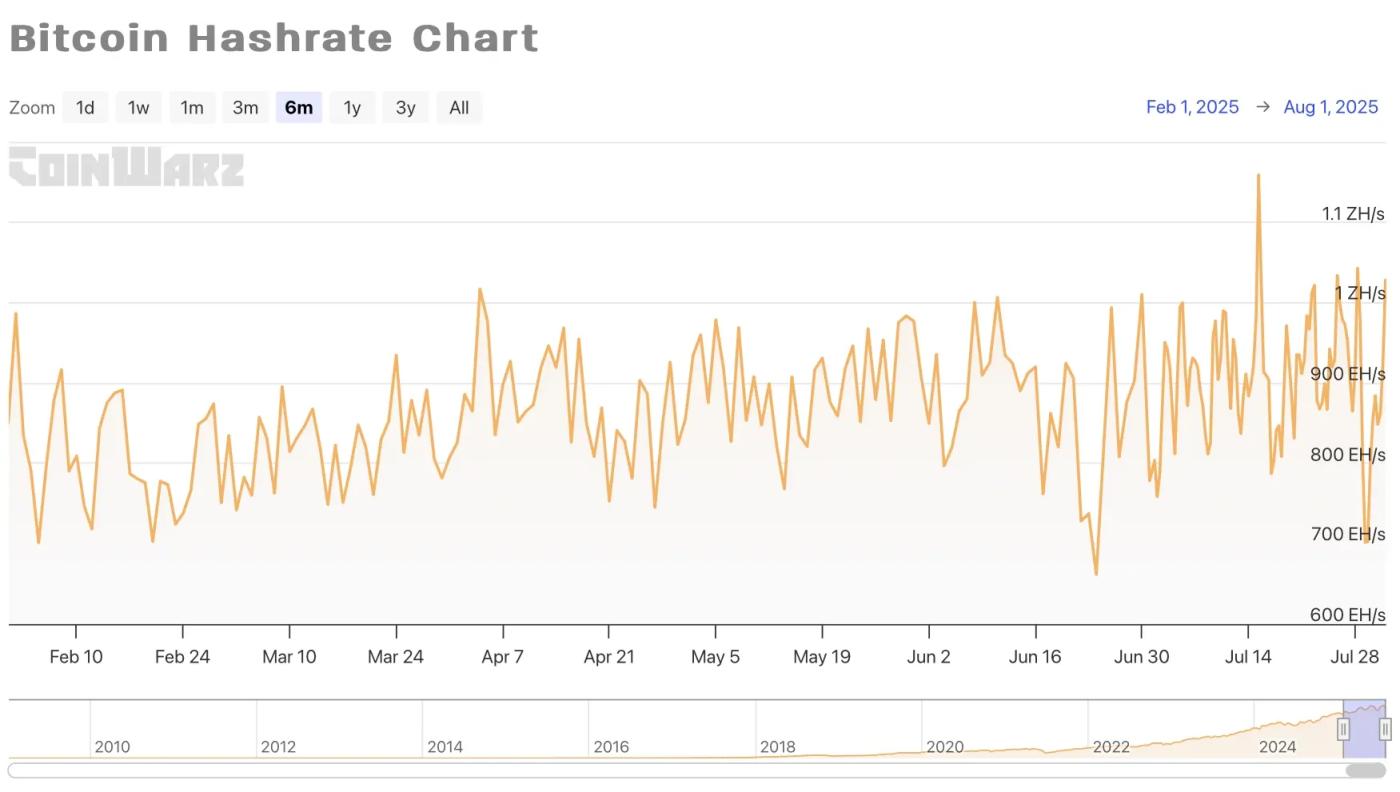
Six months of Bitcoin network hash rate data
From an annual perspective, the growth in hash rate is even more pronounced. During the same period of 2024, the Bitcoin network's hash rate was approximately 550–700 EH/s, nearly doubling the current level. This trend demonstrates the Bitcoin network's remarkable growth resilience despite multiple factors, including market fluctuations and changes in the power supply environment. This reflects the accelerating influx of industrial capital and the continuous optimization of mining infrastructure worldwide.

Annual Bitcoin network hash rate data
4. Mining income
According to YCharts data, Bitcoin miners' total daily revenue (including block rewards and transaction fees) this week was as follows: July 26: $57.61 million; July 27: $52.74 million; July 28: $57.40 million; July 29: $44.26 million; and July 30: $52.50 million. Overall, miners' daily revenue remained roughly stable this week, fluctuating between $52 million and $58 million, with slight fluctuations compared to the previous week. Notably, miners' revenue declined unusually on July 29, reaching only $44.26 million, a weekly low. On-chain data shows that the number of confirmed transactions on the Bitcoin blockchain on July 29 was significantly lower than on other days, indicating a temporary drop in transaction activity. This decrease in transactions directly reduced the total transaction fees earned that day, thereby dragging down overall miner revenue. This phenomenon demonstrates that the frequency of on-chain interactions remains a significant contributor to miners' fee income. Typically, such a decline in trading activity may be related to factors such as sideways price movement, increased investor wait-and-see sentiment, or network congestion regulation mechanisms.
From the perspective of daily revenue per unit of computing power (hashprice), according to Hashrate Index data, as of August 1st, the hashprice was $57.41 per PH/s/day, a slight decline from the same period last week, reflecting some pressure on miners' unit computing power revenue. On July 31st, the hashprice fell to a weekly low of $57.97, and on August 1st, it continued to decline, falling from an intraday high of $58.90 to $57.17. This shows that the market is relatively sensitive to multiple factors in the short term, including falling Bitcoin prices, reduced transaction fees, and fluctuations in the overall network computing power.
From a longer-term perspective, Hashprice remains in a mid-to-low range on a monthly basis, reflecting a relatively balanced balance between Bitcoin price, network difficulty, and transaction fees. Quarterly, Hashprice remains relatively high, indicating that miners maintain a certain level of profitability in the current market environment. It is worth noting that if Bitcoin prices continue to decline, on-chain activity fails to recover significantly, and the overall network hashrate continues to grow, unit hashrate returns may be further squeezed. It is important to monitor the impact of subsequent difficulty adjustments and on-chain transaction fee changes on Hashprice to determine the direction of marginal changes in miner profitability.
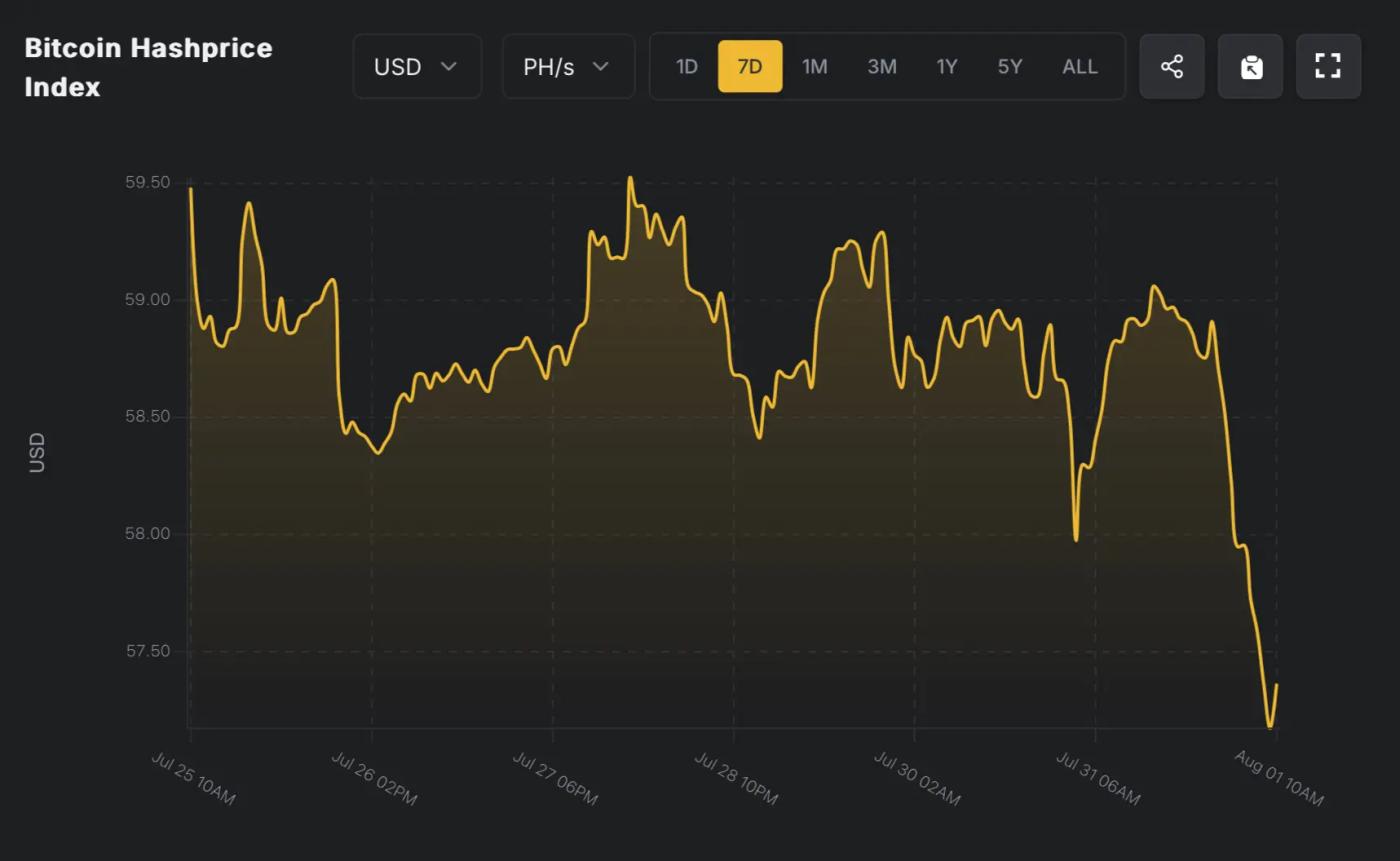
Hashprice data
5. Energy costs and mining efficiency
According to CloverPool data, as of August 1, 2025, the Bitcoin network's total hash rate has risen to 905.37 EH/s, with a mining difficulty of 127.62 T. The next difficulty adjustment is expected on August 8, with a decrease of approximately 0.31%, bringing the difficulty down to 127.23 T. This reflects that recent fluctuations in the network's hash rate are triggering the protocol's adaptive adjustment mechanism. Overall, the network's total hash rate remains at historically high levels, demonstrating that mainstream miners have maintained strong block production capacity through efficient operations.

Bitcoin mining difficulty data
From a mining cost perspective, according to MacroMicro's latest model, as of July 30, 2025, the unit cost of Bitcoin production will be approximately $99,208.77, while the spot price for the same period will be $117,831.19. This results in a mining cost-to-price ratio of 0.79, meaning miners still have an average gross profit margin of approximately 20%. Comparing the data on July 26, the unit cost was $93,178.64 and the spot price was $117,947.37, resulting in a cost-to-price ratio of 0.80. As of August 1, the cost-to-price ratio remained at 0.79. Overall, mining profit margins remained stable over the past week, and overall profitability remains substantial.
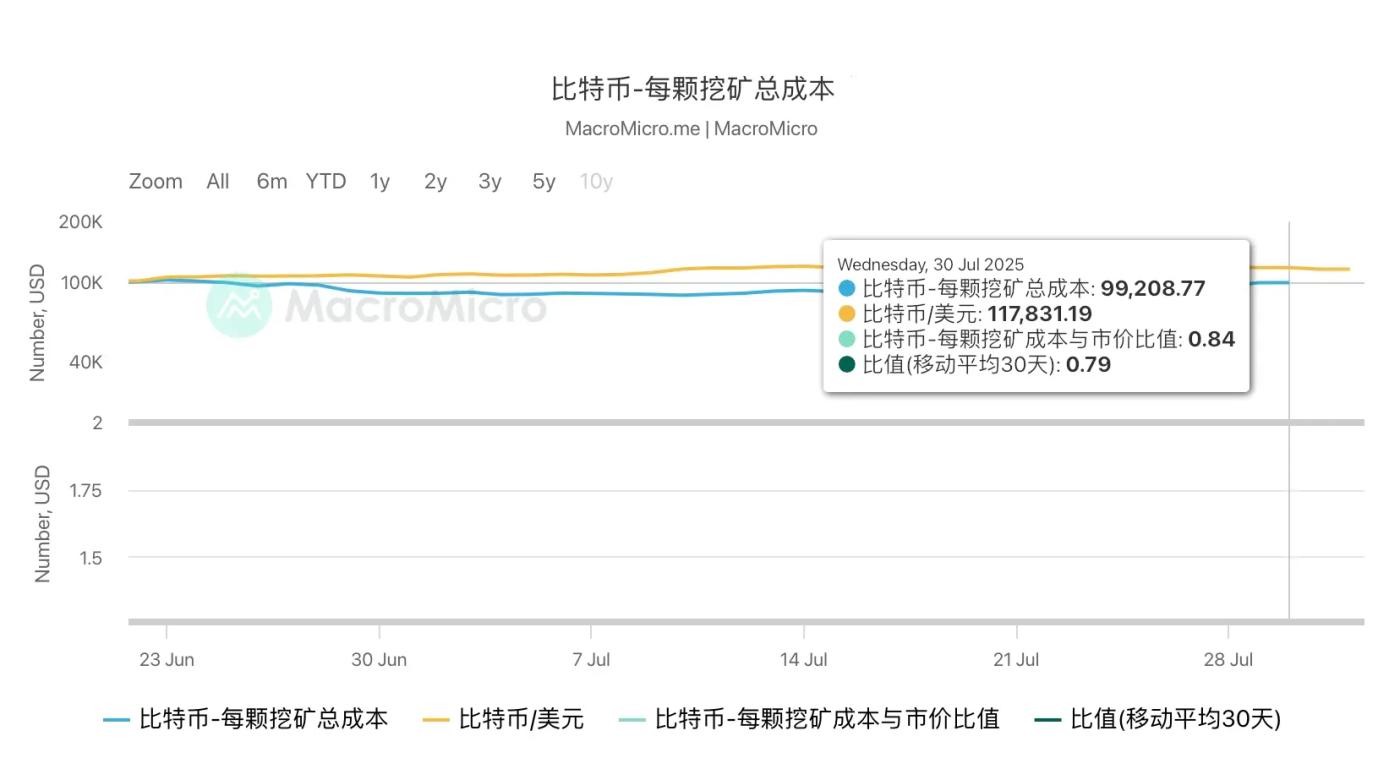
The total cost of mining each Bitcoin
Meanwhile, the on-chain Puell Multiple indicator remains in the range of 1.03–1.41, indicating that the value of daily block rewards received by miners remains above the one-year historical average, reflecting high mining revenue. Regarding daily issuance, new coins remained stable between 428 and 479 per day from July 26th to 30th, maintaining a steady supply rhythm for the network and limiting the impact on the spot market. The total crypto market capitalization fluctuates between $2.2 and $2.4 trillion, demonstrating strong market capacity for new supply and the continued positive relationship between price and cost.
Overall, Bitcoin mining remained stable and profitable this week, with mainstream miners effectively controlling marginal costs through efficient equipment, energy optimization, and scale advantages. Despite slight fluctuations in network hashrate, the overall industry remains resilient amidst current price support and healthy on-chain revenue indicators. The potential impact of rising energy costs, price fluctuations, and policy shifts on marginal mining farms warrants continued attention. In particular, inefficient mining farms or those with high energy consumption may be gradually phased out of the network, further optimizing the mining ecosystem.
6. Policy and regulatory news
Pakistan's Minister of State for Blockchain Affairs: Demographics will drive Bitcoin adoption in Pakistan to "leapfrog"
On July 27, Pakistan’s Minister of State for Cryptocurrency and Blockchain Affairs, Bilal Bin Saqib, said that Pakistan’s demographic structure makes it a major catalyst for the popularization of Bitcoin, and is expected to enable the country to “leapfrog” beyond developed countries.
“There has been a global policy shift, not just in Pakistan but around the world,” Bin Saqib said in an interview. The Pakistani government began regulating cryptocurrencies in November 2024.
The country has 40 million crypto wallets and is among the “top five” countries in terms of cryptocurrency adoption, a fact the minister attributed to Pakistan’s young population.

Related images
The US Department of Justice has filed a lawsuit seeking to seize over $2.4 million in Bitcoin linked to the Chaos ransomware gang.
On July 29, according to the U.S. Department of Justice's North Texas District Attorney's Office, the U.S. Department of Justice filed a civil lawsuit in the Northern District Court of Texas on July 24, requesting the confiscation of previously seized crypto assets.
The FBI's Dallas branch reportedly seized approximately 20.29 BTC (currently worth over $2.4 million) from an encrypted address on April 15th. The assets are allegedly linked to "Hors," a member of the Chaos ransomware group, involved in illegal activities such as money laundering and computer extortion. The group has carried out numerous cyberattacks in the Northern District of Texas and elsewhere.
The US SEC approved Bitcoin and Ethereum ETFs to be “in-kind subscription and redemption” and relaxed option position restrictions.
On July 30, the U.S. Securities and Exchange Commission (SEC) officially approved the "physical subscription and redemption" mechanism for Bitcoin and Ethereum spot ETFs on July 29, covering products from multiple institutions including BlackRock, Ark21, Fidelity, VanEck, and Franklin Templeton. This adjustment will make fund operations more efficient and reduce costs.
The SEC also approved applications for a fund of funds including Bitcoin and Ethereum spot assets, a Bitcoin ETF options product, and the relaxation of some options position limits. Chairman Paul Atkins called these moves "part of building a more rational regulatory framework" that will contribute to the depth and vitality of the US crypto market.
Analysts predict that subsequent ETF applications tracking Altcoin will also support the physical subscription model.

Related images
White House Task Force Report: Advancing the Construction of a Digital Asset Regulatory Framework, Omits Details of Bitcoin Strategic Reserves
On July 30th, the White House Digital Asset Markets Task Force will release a major report today, proposing numerous recommendations for digital asset regulation. The report recommends that the Securities and Exchange Commission (SEC) and the Commodity Futures Trading Commission (CFTC) immediately enable digital asset trading at the federal level and provide clear guidance to market participants on registration, custody, trading, and recordkeeping.
The report also addresses several key areas: supporting the integration of decentralized finance (DeFi) technologies into the mainstream financial system; promoting the development of innovative financial products through regulatory sandboxes; advancing the implementation of the GENIUS Act, a regulatory framework for stablecoins; and clarifying tax guidelines for cryptocurrency mining and staking activities. Notably, the report opposes the issuance of central bank digital currencies (CBDCs) and recommends the enactment of relevant legislation to prohibit them. The report also offers recommendations for banking services for crypto companies, calling for clear capital rules and increased transparency regarding access to bank accounts for crypto companies.
What’s not included—at least not in the preview report—are the specific details about the federal government’s progress and plans for holding a reserve of Bitcoin or other digital assets. Still, for crypto professionals who have endured more than a decade of regulatory uncertainty, it’s encouraging to see a clear set of rules taking shape in the United States, the world’s most important crypto market.
7. Mining News
An independent miner successfully mined a Bitcoin block and received 3.154 BTC, equivalent to approximately $372,000.
On July 27, Cointelegraph disclosed that an independent miner successfully mined Bitcoin block 907283 and received a reward of 3.154 BTC, worth approximately US$372,000.
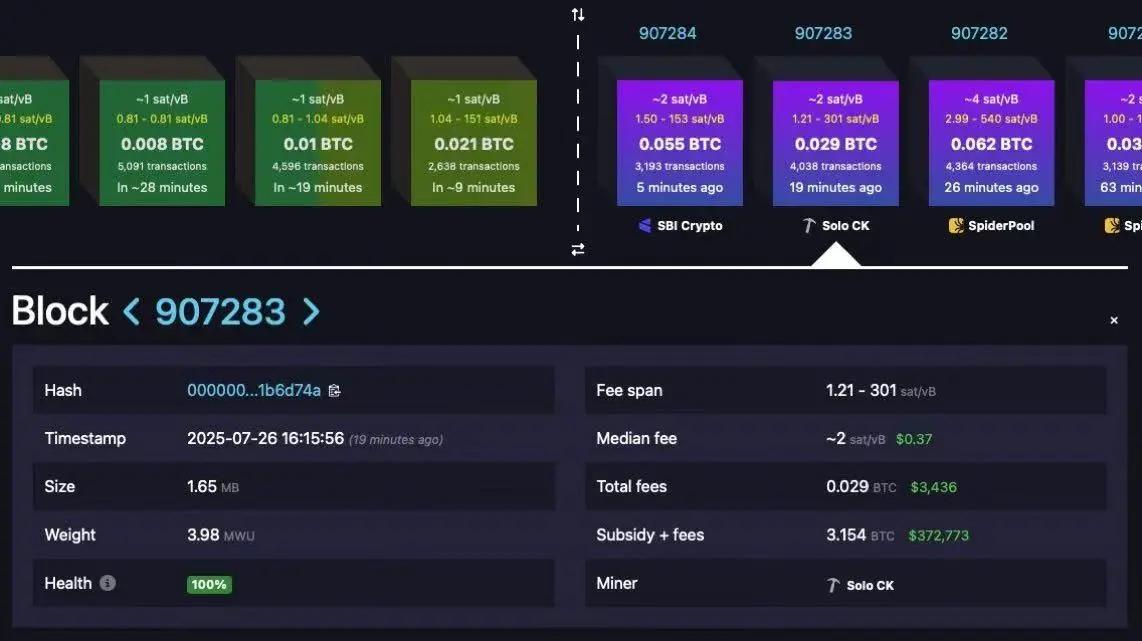
Related images
Nasdaq plans to delist Bitcoin mining company Argo Blockchain due to low stock price; the company has requested a hearing to defend itself.
On July 30, Nasdaq notified Argo Blockchain (NASDAQ: ARBK), a London-based Bitcoin mining company, of its proposed delisting due to its stock price remaining below $1. The company failed to maintain the minimum bid price requirement since the beginning of the year, triggering a delisting deficiency notice on July 15. Its current share price is $0.31, a significant drop from $16.60 when it went public in 2021.
Argo stated that it will appeal to the Nasdaq Hearings Panel, and its shares will continue to trade during the hearing. The company has not announced any plans to boost its stock price, such as a merger or reorganization, and acknowledged that there is no guarantee of success in its appeal or restoration of compliance. The mining company sold its largest Texas mine, Helios, in 2022 to avoid bankruptcy and currently operates a hydroelectric mining facility in Quebec, Canada.
Data: Over 3,500 websites attacked by secret cryptocurrency mining
On July 30, security research firm c/side revealed that over 3,500 websites had been hacked and implanted with hidden JavaScript cryptocurrency mining programs. The attackers exploited Web Workers and WebSocket technology to secretly mine cryptocurrencies while users browsed the infected websites.
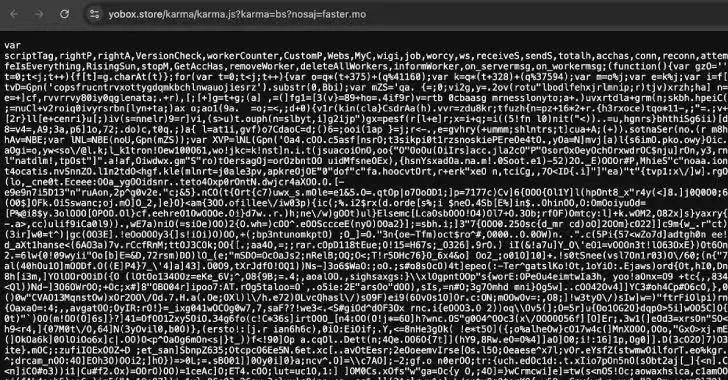
Related images
Indonesia raises taxes on cryptocurrency exchange sales and miners
On July 30th, the Indonesian government updated its tax policy for the cryptocurrency industry, increasing taxes on traders and miners while eliminating value-added tax (VAT) obligations for buyers. In addition to the income tax increase, the new tax framework reportedly increases VAT for crypto miners from 1.1% to 2.2%. Furthermore, the ministry eliminated the 0.1% special income tax rate for cryptocurrency mining. Such income will now be taxed at the personal or corporate tax rate, effective 2026.
8. Bitcoin related news
Global Corporate Bitcoin Holdings Dynamics (This Week)
1. El Salvador (country):
According to news on July 27, El Salvador has increased its holdings of 8 bitcoins in the past 7 days, bringing its total holdings to 6,250.18.
2. Monochrome (Australia):
On July 29, it was reported that the Australian Monochrome Spot Bitcoin ETF (IBTC) holdings rose to 962 bitcoins.
Bitcoin Treasury Dynamics of Publicly Listed Companies (This Week)
1. Metaplanet increased its holdings by 780 Bitcoins
On July 28, Japanese listed company Metaplanet increased its holdings of bitcoins by 780, worth approximately US$92.5 million, bringing the company's total holdings to 17,132.
2. The Smarter Web Company raised approximately £19.68 million through a rights issue and increased its Bitcoin holdings
On July 28, The Smarter Web Company, a UK-listed company, raised approximately £19.68 million through a new share placement, primarily to expand its Bitcoin holdings. The company previously held 1,825 Bitcoins. On July 30, the company announced it had increased its holdings by 225 Bitcoins at an average price of $118,080 per Bitcoin, bringing its total holdings to 2,050.
3. H100 Group has raised a total of US$114 million to purchase tokens
On July 28, Swedish listed company H100 Group announced that it had raised a total of approximately US$114 million and continued to advance its Bitcoin reserve strategy.
4. MARA Holdings issued convertible bonds to raise US$950 million
On July 28, MARA Holdings, a US-listed company, raised $950 million by issuing 0% convertible bonds to increase its holdings of Bitcoin, repay old debts and for general purposes.
5. SQNS announced an increase of 755 Bitcoins
As previously reported, SQNS announced earlier today that it had acquired 755 additional Bitcoins at an average price of $117,296 per Bitcoin (including fees). As of July 25, 2025, the company's total Bitcoin holdings reached 3,072.
6. Bakkt sells its loyalty business and raises funds to purchase tokens
On July 29, Nasdaq-listed company Bakkt announced the sale of its loyalty business for $11 million and plans to raise funds through a public offering of shares and warrants to purchase Bitcoin and supplement operating capital.
7. ZOOZ launches Bitcoin strategy with $180 million private placement
On July 29, the US stock company ZOOZ announced a private placement of US$180 million to launch a Bitcoin treasury reserve plan. Participants included well-known institutions such as Pantera Capital and FalconX.
8. Twenty One Capital becomes the world's third-largest corporate holder
On July 30, Twenty One Capital's holdings increased to 43,514 bitcoins, ranking it the third largest corporate bitcoin holder in the world.
9. Strategy purchased another 21,021 Bitcoins, raising a record amount of funds
On July 30, Strategy, led by Michael Saylor, announced it had increased its holdings by 21,021 bitcoins, bringing its total holdings to 628,791. The offering raised $2.521 billion, making it the largest US IPO of 2025.
10. 3E Network Technology Group (China) plans to establish a Bitcoin encryption reserve
On July 28, 3E Network Technology Group completed its first batch of private placement transactions and plans to use part of the funds to purchase Bitcoin and establish a crypto treasury system.
11. Profusa spends $1 million on Bitcoin
On July 30th, Nasdaq-listed Profusa announced it had invested $1 million in Bitcoin as part of its crypto treasury strategy. The company stated it will continue to use Bitcoin and other digital assets to hedge against macroeconomic uncertainty.
12. Belgravia Hartford raises $5 million in new funding for token purchases
On July 30, Belgravia Hartford, a Canadian listed company, announced the completion of a $5 million convertible bond financing with Round 13 Digital Asset Fund. It plans to use all of the funds to increase its holdings of Bitcoin (current holdings are 40.77). A separate announcement will be made after the purchase is completed.
13. Phoenix Group announces the establishment of a Bitcoin and Solana treasury with over $150 million
On July 31st, Phoenix Group, a publicly listed company in the United Arab Emirates, announced the establishment of a Bitcoin and Solana treasury valued at over $150 million as part of its long-term reserve strategy. The company currently holds 514 Bitcoin and over 630,000 Solana tokens.
Rich Dad Poor Dad author: Sometimes, gold, silver and Bitcoin are the best choices
According to CoinTelegraph on July 26, Robert Kiyosaki, author of Rich Dad Poor Dad, once again issued an article calling for holding Bitcoin: "Sometimes, holding real gold, silver and Bitcoin is the best choice."

Related images
LD Capital founder: The market has completely entered a long bull market, and the traditional 4-year cycle may disappear
On July 27th, LD Capital founder Yi Lihua posted on social media, "The market has fully entered a long bull market, and the traditional four-year cycle may no longer be a regular pattern. Stablecoins and blockchain are the best opportunities for the United States to globalize the US dollar. Investing in cryptocurrency and stocks with one hand and earning interest in stablecoins with the other, the market will continue to add new users and funds. The most popular model recently is the cryptocurrency and stock model, which is indeed an innovative invention. The crypto is too small compared to the US stock market. With the success of BTC and ETH, mainstream coins such as SUI, BNB, SOL, TON, and LTC will take advantage of this opportunity to rise to the next level, followed by smaller coins. Those with professional investment research and information capabilities can seize this opportunity. Finally, I advise against short short and stay away from short circles."
Southeast Asian ride-hailing giant Grab now accepts BTC and other cryptocurrencies for payment in the Philippines
On July 28, Adobo Magazine reported that Filipino users of Southeast Asian ride-hailing giant Grab can now use cryptocurrencies to top up their GrabPay wallets.
This feature, made possible by Grab’s partnership with payment service provider Triple-A and local digital asset exchange PDAX, will allow users to top up their GrabPay wallets with a variety of cryptocurrencies, including Bitcoin, Ethereum, USDC, and USDT.

Related images
Ray Dalio, founder of Bridgewater Associates, says investors should allocate 15% of their assets to gold and Bitcoin.
On July 28, Ray Dalio, founder of Bridgewater Associates, said in "The Master Investor Podcast" that it is recommended that investors allocate at least 15% of their portfolios to gold and Bitcoin to hedge against the increasing risks in the bond and stock markets.
He noted that the macroeconomic risks posed by rising U.S. government debt have not yet been fully priced in by the market and could trigger a significant decline. Dalio stated that he personally "strongly prefers" gold over Bitcoin and is skeptical of Bitcoin becoming a central bank reserve currency. He believes Bitcoin lacks transaction privacy and may face protocol security risks.

Related images
Galaxy Report: Cryptocurrency assets held by crypto finance companies such as Strategy have exceeded $100 billion
According to a report released Thursday by Galaxy Research on July 31st, enterprise cryptocurrency finance companies, including Strategy, Metaplanet, and SharpLink, have accumulated a combined $100 billion worth of digital assets. The report indicates that Bitcoin Finance holds the vast majority of the market, with over 791,662 bitcoins on its books, valued at approximately $93 billion and representing 3.98% of the circulating supply. Ethereum Finance, on the other hand, holds 1.3 million ether, valued at over $4 billion and representing 1.09% of the total ether supply.
According to a previous report by The Block, the total value of ETH treasury reserves of 64 entities has exceeded US$10 billion. These entities include reserve assets of listed companies, crypto exchage, DeFi protocols, non-profit organizations and the federal government.








